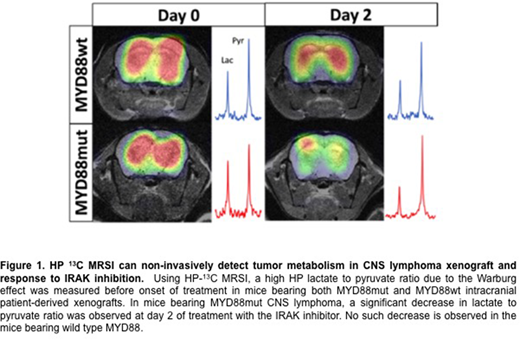Abstract
To gain insights into the tumor microenvironment in primary and secondary CNS lymphomas, we applied LC/MS and GC/MS for differential metabolomic profiling of the cerebrospinal fluid (CSF) of CNS lymphoma patients compared to control subjects. Among 145 analytes identified, the majority were involved in energy metabolism; one of the most significantly upregulated metabolites in CNS lymphoma was lactate (1.8 fold, p<0.001). Subsequently we determined that baseline elevated CSF lactate, quantified by a Beckman Coulter Unicell Clinical Chemistry analyzer, correlated with short survival in three phase I investigations involving immunotherapy in relapsed CNS lymphoma (p<0.0001). (Blood Advances 2018). Given this, we hypothesize that tumor-associated lactate significantly contributes to the pathogenesis of CNS lymphoma as a potential mediator of tumor invasion as well as immunosuppression, and can serve as a novel biomarker in CNS lymphoma. To pursue this, we are testing the hypothesis that metabolic imaging techniques including proton magnetic resonance spectroscopy (MRS) and hyperpolarized (HP) 13C MRS can facilitate prognosis and response assessment to targeted therapies.
Thus far we have applied these metabolic imaging approaches to preclinical murine models involving diffusely invasive, intracranial, patient-derived xenografts of CNS DLBCL in RAG-/- mice, to detect tumor-associated lactate production generated by infiltrating lymphoma. We demonstrated that each of these MRS approaches detect highly invasive lymphoma that is undetectable by conventional gadolinium-enhanced T1, T2 sequences, or diffusion-weighted imaging. Because of its ability to detect real-time changes in metabolic pathways, we focused on the application of HP13C pyruvate metabolic imaging as a non-invasive imaging tool for NF-kB pathway inhibition in CNS lymphoma using these models. We evaluated the metabolic response to AZ1495, a novel, CNS penetrant, orally-bioavailable inhibitor of IRAK4 kinase, comparing MYD88 wild type vs. MYD88 L265P mutant tumor models. Using a 14.1T imaging system for MR acquisition, we demonstrated similar tumor-associated production of HP 13C lactate in both MYD88wt and MY88 mutant tumors at 3 weeks post-implantation. We determined that while AZ1495 did not significantly impact lactate production in MYD88wt lymphoma, this agent significantly down-regulated tumor-associated HP pyruvate to lactate conversion (>47%) within 2 days in MYD88 mutant CNS lymphoma (p<0.02). (Figure 1). In parallel, we determined that AZ1495 potently antagonized phosphorylation of p65 REL-A selectively in intracranial xenografts harboring L265P MYD88 mutation. Transcriptional profiling by RNA-Seq demonstrated > 2-fold down-modulation of NF-kB gene expression at 4h of AZ1495 therapy, including transcripts encoding LDH-A as well as the catalytic subunit of PI3K, suggesting interaction with the B cell receptor pathway. Combination AZ1495 plus ibrutinib starting d+5 was synergistic in survival prolongation compared to AZ1495 monotherapy (p<0.003), ibrutinib monotherapy (p<0.005), or control gavage (p<0.002) in a MYD88 L265P mutant, clinically refractory patient-derived intracranial DLBCL xenograft model. Taken together, these data demonstrate the ability of HP13C MRI metabolic imaging to identify highly infiltrative CNS lymphoma, not detectable by conventional MR sequences, as well as its potential to provide an early, non-invasive pharmacodynamic biomarker of response in an NFkB pathway-specific manner, and to facilitate precision medicine in CNS lymphoma. Supported by the National Cancer Institute, the Leukemia and Lymphoma Society and by the Sandler Program for Breakthrough Biomedical Research.
Gao:Glaxo Smith Kline: Employment. Drew:AstraZeneca: Employment. Degorce:Astra Zeneca: Employment. Mayo:Astra Zeneca: Employment. Dillman:Astra Zeneca: Employment. Anjum:Astra Zeneca: Employment. Bloecher:Astra Zeneca: Employment. Rubenstein:Celgene: Research Funding; Genentech: Research Funding.
Author notes
Asterisk with author names denotes non-ASH members.


This feature is available to Subscribers Only
Sign In or Create an Account Close Modal